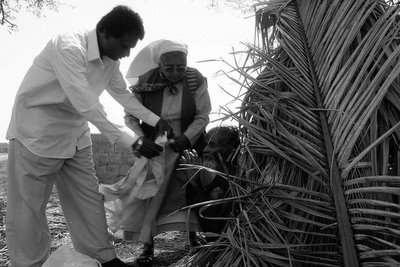
It was early and the generator next door blasted away. Eric was coming down the next day from the States for us to do a film on “Leprosy” for National Geographic and pre production was on full swing. I crawled out of bed to the balcony for tea and the Times of India newspaper.
Page three.
Hey that’s x with y and what is P doing with K and what the hell is she wearing?
I turned the page and there in the corner, under an ad for Television sets (exchange offer with free VCD rack and 10 Hindi movies) was a tiny article about an old man suffering from leprosy who had been thrown out of his village a few hours away from
Fine, I thought, he’s going to have NGO’s rushing the village, fund folders in hand.
Post breakfast I called up Father George at the Sumanahalli rehabilitation home for leprosy patients (the term “Lepers” is considered derogatory and is not used) and after a quick meeting with Sister Mary Mascarenahas I hired a jeep and we headed out. Several hours later past miles of featureless fields we reached the featureless village, nondescript, off the highway, and cruised its empty street. Potholes, dogs, dirt, no NGO's, no outcast.
We reached the teepee and wasting no time. Sister Mary inquired within. Fakirappa emerged, skinny, stinking and naked. He could not stand and was dehydrated, starving, his body covered in sores. The crowd seemed angry. I felt a little nervous. Eric kept his distance and filmed away. I muttered to him that he needed to get closer and Eric was annoyed. It was about the first day of the shoot and despite our knowledge on how incommunicable the disease was, we were nervous. Later on, I would be disgusted with myself.
I recall various political conversations with journalists, artists, priests and social workers over endless cups of tea. I recall fists pounding table over international issues, George Bush,
More tea please.

Sister Mary washed him, clothed him and with the help of her assistant and a villager whom she forcibly berated into service, they carried Fakirappa to the car. He was as light as a child. The villagers told us to take him away. He was not wanted. Sister Mary stood in front of the car and gave them a scolding, finger waving, followed by a course on leprosy and how easy it was to cure and contain. She bandaged his open wounds. They listened.
As the car doors closed the villagers set fire to Fakirappa’s shelter. After shooting the same (it would make a dramatic and stark ending to the scene), we left.
We stopped for lunch on the ride back to the Sumanahalli home for leprosy patients and Fakirappa ate in the car. The restaurant would have created a scene. Leprosy patients don’t really have it easy. Nearly all have been cured of the disease itself but the deformations caused make them outcasts unable to get employment, a seat on a bus or a meal in a restaurant.
Most often their families throw them out on the street due to the social stigma attached to the disease where they have no option but to beg. Many Leprosy patients or former leprosy patients have alcohol and drug problems. Their scars are not just physical but emotional. No love in their lives but rejection, disgust and apathy.
Sumana means 'Goodwill' and Halli means 'Village'. The objective of Sumanahalli is the eradication of leprosy, the treatment and rehabilitation of leprosy-affected people and their reintegration into society.
Check it out on www.sumanahalli.org.
Visit them if you want. Its off Magadi road in Bangalore. Pyarijaan is a lady with no face who loves to sing and she laughed hysterically at our American documentary type questions. She is one of the happiest people I have ever met.
Pyarijaan
To cut a long story short we shot a short film on leprosy sufferers for the “Taboo series” for National Geographic Television. It appears in their “outcast” hour. I am yet to watch the show on TV. They are yet to send me a tape.
Fakirappa recovered but only just, managed to get himself a loan from the Chief Ministers fund with Father George help and eventually returned to the village, set up business and is doing okay apparently. Sister Mary “educated” the village regarding leprosy.. As I type this sentence, she calls me for the first time in ages.
I wondered what I would have done if I was not shooting a film on leprosy. Would I have taken the trouble to look into Fakirappa, cleaned his sores and rescued him?
I would not have.
In India I am surrounded by poverty and it has become a part of the landscape, like the trees and buildings and conversations and the same party I have been going to for ages.
I found that Fakirappa being rescued, indirectly because of me, affected me. I didnt know him, i couldnt care less about him and Fakirappa had only taken on importance becasue of the film we happened to have been working on. Somedays I think about the starving old man we pulled out from under those leaves in that featureless field and imagine him on his house verandah in that featureless village and wonder what would have happened if had had subscribed to the Deccan Herald instead of the Times.
We live removed from the realities that surround us. Middle class India is on the "move" the papers say but there live in our slums and streets a huge underclass who have very little. Talk is cheap so I will stop typing and hope these images speak for themselves.









0 comments:
Post a Comment